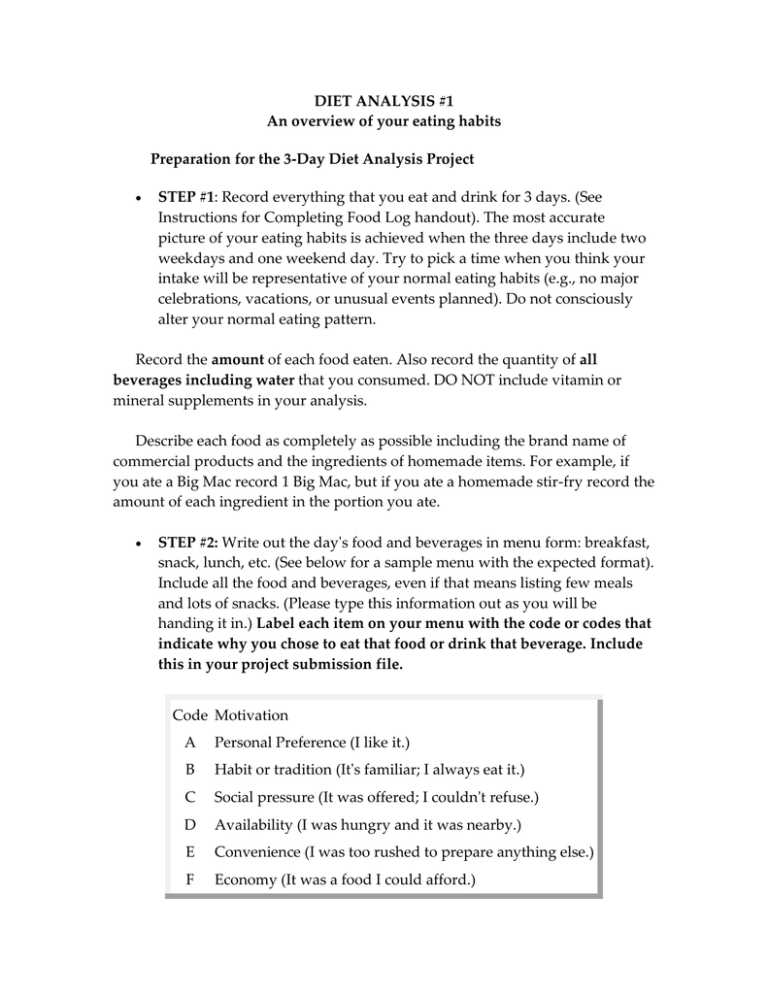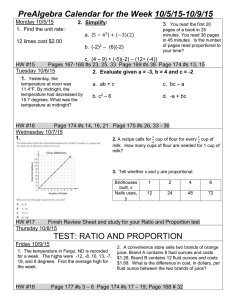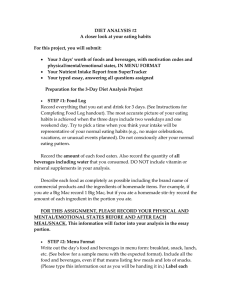DIET ANALYSIS #1 An overview of your eating habits STEP #1
advertisement

DIET ANALYSIS #1 An overview of your eating habits Preparation for the 3-Day Diet Analysis Project STEP #1: Record everything that you eat and drink for 3 days. (See Instructions for Completing Food Log handout). The most accurate picture of your eating habits is achieved when the three days include two weekdays and one weekend day. Try to pick a time when you think your intake will be representative of your normal eating habits (e.g., no major celebrations, vacations, or unusual events planned). Do not consciously alter your normal eating pattern. Record the amount of each food eaten. Also record the quantity of all beverages including water that you consumed. DO NOT include vitamin or mineral supplements in your analysis. Describe each food as completely as possible including the brand name of commercial products and the ingredients of homemade items. For example, if you ate a Big Mac record 1 Big Mac, but if you ate a homemade stir-fry record the amount of each ingredient in the portion you ate. STEP #2: Write out the day's food and beverages in menu form: breakfast, snack, lunch, etc. (See below for a sample menu with the expected format). Include all the food and beverages, even if that means listing few meals and lots of snacks. (Please type this information out as you will be handing it in.) Label each item on your menu with the code or codes that indicate why you chose to eat that food or drink that beverage. Include this in your project submission file. Code Motivation A Personal Preference (I like it.) B Habit or tradition (It's familiar; I always eat it.) C Social pressure (It was offered; I couldn't refuse.) D Availability (I was hungry and it was nearby.) E Convenience (I was too rushed to prepare anything else.) F Economy (It was a food I could afford.) G Health value (I think it is healthy for me to eat.) H Advertising. I Other (explain). STEP #3: SuperTracker Here are the steps you’ll take to use the SuperTracker website (https://www.supertracker.usda.gov). This website will calculate your estimated nutrient needs and compare them with the totals from your 3-day intake. You will use this information to analyze your intake. 1. Create a profile on the website. This only takes a couple of minutes, and you will answer questions that the website uses to calculate an estimate of your energy and nutrient needs. 2. Log into your profile. 3. Once logged in, click on the Food Tracker link. Once in Food Tracker, you can search for foods and beverages and add them to your day. Be sure to adjust for the correct quantity of each food before adding. 3. Once you've added all your food and beverages, hover the mouse over My Reports and click on Nutrients Report. To generate your report, enter the date range covering your 3day intake. 4. In the upper right corner of the screen, there is the option to export the report to a variety of formats. Export the report to any of the file formats. Save the file and submit it with your project. 5. Once you create a profile in SuperTracker, the website will save your data, and you can access your input by the date you entered it. Just log back in and click on Food Tracker, where you can use the calendar tool access a particular day's data. STEP #4: Essay Please be sure to use double spacing and 12 point Times New Roman. Also, please remember to include your intake for the day in menu format, as well as the Nutrients Report from SuperTracker. You do not need a cover page. To answer the questions thoroughly, you should need 1-2 pages. Be sure to complete the assignment in continuous essay format. Do not write the question and then the answer…and use full paragraphs! A well-written paragraph contains an introduction, supporting sentences that elaborate on the topic at hand, and a strong conclusion. The 1-2 pages do not include your menu and SuperTracker chart. 1. List any vitamins and minerals that averaged less than 100% of the recommended amount. 2. For each vitamin or mineral that averaged less then 100% of the recommendation, suggest one food that would increase the amount of that nutrient in your diet. 1. Why did you pick the food? Is realistic to YOUR diet? 2. Suggest a way you would incorporate the food directly into your diet. 3. How much sodium did you consume? Sodium recommendations are listed as a UL (tolerable upper intake level). Was your intake at or below the recommended amount? What foods in your 3-day intake are highest in this mineral? (Next to each nutrient listed in the Nutrient Intake Report, there is a plus sign (+). You can click on the “+” to see a list of foods providing that particular nutrient, and these foods are listed in order from greatest to lowest contribution.) 4. How many different fruits and vegetables did you consume daily? a. Could your diet benefit from more diversity? b. How is diversity in the diet beneficial? 5. What have you learned about your eating habits? 1. Note the motivation codes you assigned to your foods. 2. Offer observations: what are your primary motivations when it comes to food choices? 6. As a conclusion, summarize what you have learned from this exercise. Include here any thoughts on modifications you might make to your eating habits or behaviors. Be sure to list at least one specific change you would make (for example: I would incorporate a baked sweet potato with dinner to increase my vitamin A intake). Step #5: Turn in your report. Please remember to include all of the following: 1. Your 3-day menu 2. Nutrients Report from SuperTracker 3. Essay, with all questions answered in continuous essay format Sample Menu After you record your intake for the day, organize it as follows in menu format. In parentheses following each item is the motivation code for that item, as described above. Please note that, where possible, foods are grouped according to the dishes to which they belong (e.g., Tacos: 4 corn tortillas, 6 ounces beef, ½ cup tomato salsa, ¼ cup cilantro). Monday, 11/28/11 Breakfast (7:00am): 8 fluid ounces water (B, G) 1 slice sprouted grain bread (G) 1 tablespoon unsalted almond butter (A, G) 1 apple (A, G, D) 16 fluid ounces green tea (A, G, B, I: caffeine to help wake me up) Morning Snack (10:15am): 1 hard-boiled egg (D, G, F) ¼ teaspoon salt (A) 1 pear (D, G) 12 fluid ounces water (B, G) Lunch (12:30pm): 12 fluid ounces water (G) Salad: 2 cups mixed baby lettuces (A, G) 1/3 cup marinated artichoke hearts (A, G) ¼ cup sliced black olives (A) ¼ cup grated carrot (A, G) ½ cup raw broccoli (G) 1 tablespoon balsamic vinegar (A, B) 2 tablespoons extra-virgin olive oil (A, G) ¼ teaspoon salt (A) 6 ounces grilled chicken breast (B, D) Soup: 1 cup butternut squash (A, G) ¼ cup chopped onions (A) ¼ teaspoon salt (A) 2 teaspoons extra-virgin olive oil (A, G) ½ cup chicken broth (A) Afternoon Snack (2:45pm): 2 ounces dark chocolate (A, I: helps perk me up when I’m tired) 1/4 cup raw walnuts (G) 1 tangerine (A, D, G) 16 fluid ounces green tea (B, G, I: caffeine) Between snack and dinner: 16 fluid ounces water (G) 8 fluid ounces English breakfast tea (I: caffeine) Dinner (8:30pm): 5 fluid ounces red wine (A, I: helps me relax) 12 fluid ounces water (B, G) Tacos (from taco truck): (E) 4 corn tortillas (A, G) 6 ounces beef (flank steak) (A) ½ cup tomato salsa (A) ¼ cup cilantro (A, G) Rice: 2 teaspoons extra-virgin olive oil (A, G) 1 cup cooked brown rice (A, G) 1 teaspoon tomato paste (A) 1 clove garlic (A, G) 1/8 teaspoon salt (A) Slaw: 1½ cups sliced red cabbage (A, D, G) ½ cup grated carrot (A, G) ½ cup grated beet (A, G) 1 tablespoon extra-virgin olive oil (A, G) 2 tablespoons lime juice (A) 1/8 teaspoon salt (A) Dessert: 1 cup Coconut Bliss ice cream (Hazelnut Fudge) (A)




